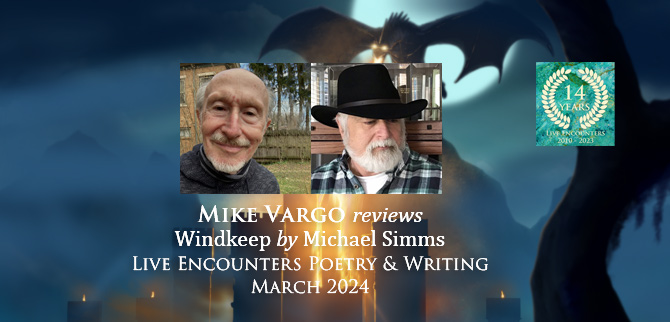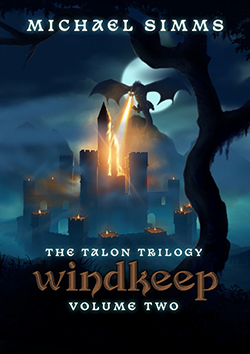
Live Encounters Poetry & Writing March 2024.
Michael Simms
Windkeep:
The Second Chronicle of Tessia Dragonqueen
(The Talon Trilogy) – Book review by Mike Vargo
Book available at: https://amazon.com
 Sequels are special cases. During much of the history of Western culture they’ve been rare in serious literature and drama. Beckett didn’t follow Waiting for Godot with Still Waiting, and Jane Austen wrote standalone novels, leaving later writers to sequelize them. But the inclination to write followups has existed for a long time, as have audiences who want more. The novel we now call Don Quixote consists of two: an original and a sequel published years apart in the early 1600s. Cervantez’s contemporary, Shakespeare, created a de facto series with Henry IV Parts 1 and 2 and Henry V, plus a Falstaff spinoff in The Merry Wives of Windsor.
Sequels are special cases. During much of the history of Western culture they’ve been rare in serious literature and drama. Beckett didn’t follow Waiting for Godot with Still Waiting, and Jane Austen wrote standalone novels, leaving later writers to sequelize them. But the inclination to write followups has existed for a long time, as have audiences who want more. The novel we now call Don Quixote consists of two: an original and a sequel published years apart in the early 1600s. Cervantez’s contemporary, Shakespeare, created a de facto series with Henry IV Parts 1 and 2 and Henry V, plus a Falstaff spinoff in The Merry Wives of Windsor.
Then, around the mid-20th century, the scene began to shift. Series built on continuing sets of characters moved upscale, from detective stories and the Tarzan books to Lawrence Durrell’s Alexandria Quartet and John Updike’s Rabbit novels. And the works that reverberated the most came from two British authors who were old pals. J.R.R. Tolkein’s Lord of the Rings novels piled a mega-trilogy atop his earlier book The Hobbit, while C.S. Lewis rolled out the seven-volume Chronicles of Narnia.
Together, the two series set multiple precedents. Both the Narnia books and Hobbit+LOTR were originally aimed at young readers but also grew popular among adults. Both helped to establish fantasy-world fiction as legitimate literature, the kind that scholars analyze. Moreover, their success served as proof of concept for a creative approach that has spread. If you’re going to invent an entire imaginary world, and invite readers into it — a world beyond the real which somehow reflects the real, operating by its own customs and laws of nature, where colorful characters are caught up in tensions between the good and the no-good — if you’re doing all that, then you should endow that world with a long-running saga, not merely a one-off story.
And so it came to pass that J.R.R. and C.S. begat J.K. and George R.R., and many others.
Within this context, let’s look at a new book in a series that hasn’t already been discussed half to death. Windkeep is the second novel in the planned Talon Trilogy, by Michael Simms.
Simms (no initials) comes to world-building from an unusual direction. For years he’s been primarily a poet and is best known as one. His first venture into long-form fantasy fiction was rather unusual, too. Bicycles of the Gods (Madville, 2022) presented a new take on the Second Coming: Jesus is sent to Earth with his fellow god Shiva, Destroyer of Worlds, who’s eager to help cleanse the planet of sinful humans. The two arrive incognito, swooping into Los Angeles incarnated as 12-year-old boys on cool bikes. Bicycles still awaits a hoped-for sequel because meanwhile, Simms has launched the aforementioned trilogy. Which unfolds in a different sort of world entirely.
The Talon Trilogy is set in an imaginary land where the living standards appear to be early medieval and most technologies are Bronze Age: “copper” is a widely used metal. But the main characters include a dragon, and the tech arsenal includes magic. Madville published volume one, The Green Mage, last year. And of course one should read it before starting Windkeep, its sequel. That won’t be a chore.
The Green Mage is very good. In this book, Simms showed that an experienced writer with a vivid imagination can take a fairly standard sword-and-sorcery plot and make it sing. The story is narrated by the title character, an itinerant trader who uses his green (healthy) magic sparingly, to avoid upsetting nature’s balance. He gets drawn into a campaign to overthrow a corrupt and cruel regime. The rebels are led by a brave young woman, who recruits the dragon as an ally. They battle a dark wizard, usurper of the elderly king, and — necessary spoiler — the good guys win. For a while, everything is rosy. Curtain.
Windkeep resumes the saga a few years later. The bloom is off the rose. Tessia, the fiery young warrior from the revolution, has become queen. But she’s screaming-heebie-jeebies bored with the business of governing, and civil society is coming unglued. A rustic but once-thriving economy now sputters; the people are restless. Worse, the weather has turned dry and blistery, in a drought that augurs doom for the farmers who feed all.
This setup does the things you’d want fantasy fiction or indeed any fiction to do. We have a central character whose predicament rings psychologically true. Dramatic tensions are cranked high. The fantasy world faces challenges that have real-world parallels. And author Simms’s writing — channeled again through the voice of the Green Mage, now a counselor to the queen — comes across clear and un-fancified. You are moved briskly into the story by a narrator who puts you tangibly there on the ground, in the rooms where it’s happening.
The special requirements of a sequel are nicely met, too. The same core characters you’ve gotten to know are seen in different circumstances, which drive them to develop or reveal different sides of themselves. Further, Windkeep does more than give the characters a new set of problems to solve. It transports them to a new dimension; draws them into a game in which the rules and the playing field are new and uncertain.
In The Green Mage, magic spells come into play only sometimes and are usually aimed at individuals. In Windkeep, spells are cast prolifically and they’re cast with wide-reaching nets. It seems that blue witches, an advanced breed, influence the changing climate. On a mission to track down the witches, Queen Tessia and company trek into territories where nature has been modified. Tiny forests of tinier-than-bonsai oak trees grow underfoot. There are talking sheep and hybrid creatures, part one animal, part another. It’s unreal but also makes you think Oh, wait — maybe this isn’t so different from what’s going on in the real world.
And the dragon. In volume one we learn that the she-dragon Tyrmiss thinks, feels, and speaks on a human level. In Windkeep she is revealed as a superior being, not just for her abilities to fly and spit fire, but above all for her penetrating wisdom, keen moral sense, and common-sense eloquence. Although Tyrmiss declines to hold office, she’s the very model of an ideal prime minister.
Do the allegories and real-world analogies feel overdone at times? They do. But the pace of Windkeep, a page-turner like its predecessor, should keep a reader too busy to worry about imperfections. For anyone who wants to try out a fantasy-fiction world, I’d say the Talon Trilogy books offer an engagingly wild ride in a much more compact vehicle than you might find elsewhere. Windkeep wraps up within a tight 299 pages. If the trend holds, volume three shouldn’t be long in the coming or in the reading thereof.
© Mike Vargo
Mike Vargo, a freelance writer based in Pittsburgh, is a former journalist who held editorial posts in both mainstream and alternative media. He has won major awards for his in-depth reporting as well as for other work. Currently he writes creative nonfiction and reviews, and collaborates with subject-matter experts on nonfiction books.
Michael Simms lives in Pittsburgh, Pennsylvania, USA. He is the author of three novels and four collections of poetry. His poems have appeared in Poetry (Chicago), Plume, and Poem-a-Day published by The Academy of American Poets. He is also the founding editor of the online journal Vox Populi. In 2011, Simms was awarded a Certificate of Recognition by the state legislature of Pennsylvania for his service to the arts.


Thank you so much for this perceptive review, Mike!